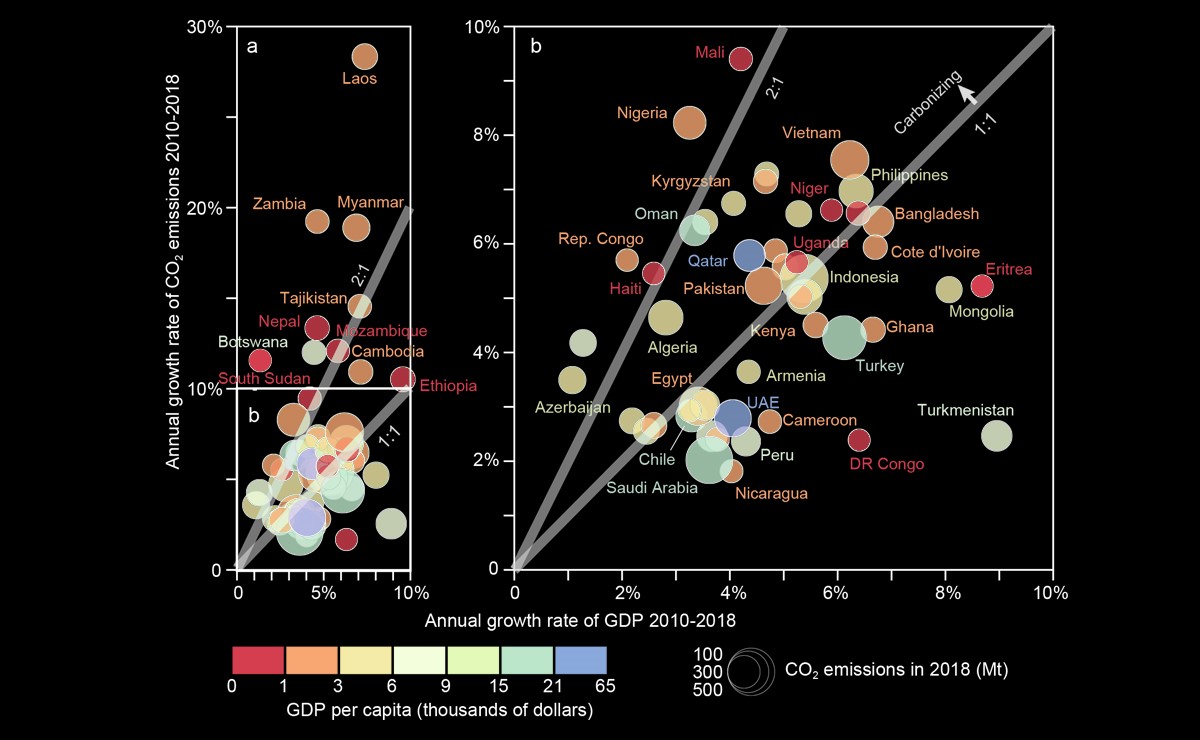Unless new policies are introduced aimed at 59 countries in which carbon dioxide emissions are surging, there is likely to be an increase in average global temperatures of 2.5°C, say researchers.
A new group of emerging emitters speeding past the large greenhouse gas emitters of old – the United States, European Union, India and China – are quickly re-writing the climate change story, says Dabo Guan, a distinguished professor of climate change economics at Tsinghua University.
In a study published in October 2022, Guan and an international team of experts defined emerging emitters as countries with emissions growing faster than the average of all nations’ (excluding China and India). What they found was that the emissions in these 59 countries “were growing faster than we expected”, says Guan.

Dabo Guan, a distinguished professor of climate change economics, was a lead author for the chapter on regional development and cooperation for the 5th Assessment Report (AR5) of the Intergovernmental Panel on Climate Change (IPCC), a key document in the establishment of the 2015 Paris Agreement.
Expectations based on previously published scenarios that would limit global warming to 1.5°C or even 2°C will need to be re-set, he says. Guan was a lead author for the chapter on regional development and cooperation for the 5th Assessment Report (AR5) of the Intergovernmental Panel on Climate Change (IPCC). AR5 was a key document in the establishment of the 2015 Paris Agreement, when almost 200 states agreed to take action to reduce greenhouse gas emissions to limit global warming to well below 2°C compared to pre-industrial levels. The 6th Assessment Report is currently being written ahead of 2023’s United Nations Climate Change Conference in the United Arab Emirates.
International mitigation efforts focus on the large emitters and, to some extent, neglect the emerging emitters, Guan warns. “Without any new policies, these emitters are most likely putting us on a trajectory for 2.5°C rise in global average temperature,” he says.
These unanticipated emissions require urgent non-emitting energy deployment across these emerging emitters, and faster and deeper reductions in emissions from other countries, say the authors. “We’re calling for more attention on emerging emitters because their emissions are growing faster than we imagined,” says Guan.
2.5°C scenario likely
Between 2010 and 2018, it appears that all major emissions growth has come from China, India and these emerging emitters, Guan explains. Based on data from the International Energy Agency, his group showed that the average annual growth rate of emissions was 6.2% – the average of all nations worldwide was 2%. Collectively the annual emissions of the emerging emitters grew by roughly 41% in this eight-year period.
In fact, the study showed that the aggregated emissions of emerging emitters were larger than India, “which caught our attention”, Guan says. The two Asian populations giants, India and China, have actually gradually flattened their emissions, he says, and thus global emissions’ increments are currently dominated by the emerging emitters.
“We are at a tipping point for energy transition,” explains Guan. Emerging emitters are countries in development categories ranging from the least developed country to economy in transition. In most cases with gross domestic product per capita substantially less than the global average. From their analysis of historical emissions drivers, Guan’s group shows that industrialization and extended energy infrastructure are the driving forces of the emissions surges and these factors are likely to continue to cause emissions to grow.
So, what can be done?
There are huge differences among these emerging emitters, notes Guan. Each has a unique economic status and disparate circumstances, he says,
Some emerging emitters have recognized the necessity of carbon neutrality and already started the energy transition to decarbonize already. For example, the study showed that emerging emitters, Uganda, Peru, and Colombia are already decarbonizing with carbon and energy intensity indicators both decreasing in recent years. They all also maintained population and GDP growth, Guan points out. “However, they absolutely have potential for lower carbon energy systems that will comprise hydro, geothermal, and solar energy,” he says. “We will see a more promising model of development tomorrow than today.”
 This shows the relative increase between 2010 and 2018 of carbon dioxide (CO2) emissions and Gross Domestic Product (GDP) for the 59 ‘emerging emitters’, countries with emissions growing faster than the average of all nations’ (excluding China and India). The clustering of low GDP per capita countries at the top of the chart suggests that growing economies with low GDPs tend to see their emissions increase significantly. *The lower grey lines marks the point where the CO2 emission growth rate is the same as GDP growth. Countries above this line are on their way to continuing to steadily increase their CO2 emissions.
This shows the relative increase between 2010 and 2018 of carbon dioxide (CO2) emissions and Gross Domestic Product (GDP) for the 59 ‘emerging emitters’, countries with emissions growing faster than the average of all nations’ (excluding China and India). The clustering of low GDP per capita countries at the top of the chart suggests that growing economies with low GDPs tend to see their emissions increase significantly. *The lower grey lines marks the point where the CO2 emission growth rate is the same as GDP growth. Countries above this line are on their way to continuing to steadily increase their CO2 emissions.
Other countries rely on energy mixes that are more carbon-intensive, but cheap, which suits varied priorities, including meeting many of the United Nation’s sustainable development goals that focus on better, more equitable living conditions. In 2017, the authors point out that emerging emitters were home to 698 million people living on less than US$1.9 per day in purchasing power parity value.
“These economies are not decoupled from emissions, yet,” Guan points out. The coupling of carbon dioxide emissions and gross domestic product is currently considered necessary in early stage industrialization. “Meanwhile, the annual costs of keeping emissions at a low level are in many cases 0.2%–4.1% of a countries’ gross domestic product, so there are trade-offs with poverty reduction goals and low-carbon technology investment,” says Guan.
“Emerging emitters need to decarbonize without jeopardizing living conditions and economic development,” he argues. He thinks that this will mean that emitters that are already industrialized should help by decreasing their emissions more to create more room for emerging emitters. Other countries should also provide support and assistance, technically or financially, to help the emerging emitters install the right technology as they industrialize, setting them a path towards a low carbon future.
Installing systems for solar, wind, hydraulic, and geothermal energy requires financial support from countries that have historically had large emissions and have mitigation experience, argues Guan. “We know that Denmark has invested heavily in supporting with climate-change adaptation in 24 countries, representing 70% of the global CO2 emissions, including Kenya, South Africa, Egypt and Ethiopia, for example,” says Guan. Emerging emitters Myanmar, Laos, Zambia and Ethiopia are all on their way to industrialization, and probably lack the means to install low carbon developments on their own, he says.
Playing out the scenarios
“If emerging emitters stop their emissions surging, and other countries stay on track for the 1.5° scenario – globally we’re likely to land at a 2.2° rise in global average temperature,” Guan says. The achievable rate of emissions reductions sits somewhere between the 2.5°–2.0° scenario and the 2.0°–1.5° scenario.
In an ideal world however, Guan says, emerging emitters reduce by nearly 4% a year and other countries reduce emissions by a significant 5% a year to pursue a global 1.5°C target. That’s close to the goals of the 2.0° rise in temperature scenario for emerging emitters.
But if the emerging emitters aim to collaborate with other countries toward a common 1.5°C target, they need a huge amount of help from other countries, Guan stresses. For that reason, it’s urgent that they get this help, he says.
“And of course, academia can work harder to call for more action from the non-emerging emitters,” he says.
Guan co-ordinated this research for the Carbon Emission Accounts and Datasets, a group of experts from the United Kingdom, the US and China who work on emission accounting for China and other emerging economies.
Related
A global inventory of oil refineries reveals an expansion of high emission new facilities in Asia and the Middle East.
Reference
Cui, C., Guan, D., Wang, D., Meng, J., Chemutai, V. et al. Global mitigation efforts cannot neglect emerging emitters National Science Review nwac223 (2022) doi: 10.1093/nsr/nwac223
Editor:Guo Lili